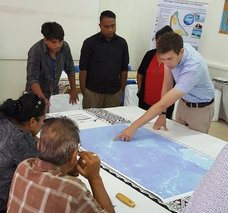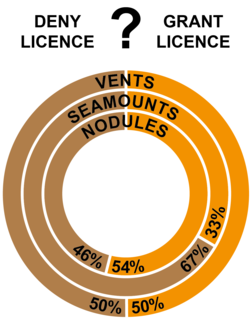 From the ocean around South Georgia, Professor Richard Sanders writes: "It's now a little less than a week since we sailed and we are now sitting in the heart of the South Georgia bloom, one of the largest and most sustained open ocean phytoplankton blooms on the planet, and a major natural sink for atmospheric carbon dioxide." This expedition forms part of the COMICS project, which is all about understanding how material sinking from the ocean surface contributes to carbon storage in the ocean, away from the atmosphere, where it could contribute to climate change. NOC scientist Dr Steph Henson added: "You might think that means we have to actually catch the sinking material to study it. We do that too, but we can also get information about the particles in the water using ocean robots. Filipa and I have the job of looking after ocean gliders - autonomous underwater vehicles that can survey the ocean for months at a time without needing a ship." On another note, scientist Jo Ainsworth may have played the first ever Euphonium recital on the Southern Ocean. All is revealed in the COMICS expedition blog, which also features Jo's thoughts and experiences of her first research expedition.  This week's episode of Blue Planet 2 talked about how half the animals in the open ocean drift in ocean currents. Earlier in the year NOC scientists published a paper on how climate change driven alterations to these currents could have a greater impact on marine ecosystems than acidification, de-oxygenation or warming. Read this research here. The programme also featured a section on the impact of plastics in the ocean. NOC scientists have been investigating the abundance, distribution and fate of microplastics in the open ocean, covering the entire water column and deep-sea sediments. Read this article to find out more. |
 This week NOC scientists Dr Daniel Jones, Dr Tammy Horton and Dr Rob Young, have been in Kiribati hosting a workshop with the Kiribati Ministry of Fisheries and Marine Resources Development on deep-sea mining environmental baseline assessment. This workshop discussed the resources, values and possible impacts of potential deep sea mining with a wide range of stakeholders in Kiribati including government ministries, industry and community groups. This activity is part of the Commonwealth Marine Economies (CME) Programme, which is being delivered on behalf of the UK Government by a partnership of the United Kingdom Hydrographic Office (UKHO), the Centre for Environment, Fisheries and Aquaculture Science (Cefas) and the NOC. |
 Last weekend two teams of scientists from the NOC participated in a massive free public interactive science showcase in Edinburgh. At #UnEarthed2017 we shared our work looking at deep-sea mineral-rich rocks and environments. Could these rocks hold the key to finding new reserves of vital resources? Visitors were able to see and touch these deep-sea rocks, learn about the robots helping to investigate them, and about the impact deep-sea mining might have on the local ecosystems. After discovering the role minerals play in our modern day lives, such as in smartphone batteries, green technology and televisions, we asked visitors to either grant or deny mining licences. Our goal was to provoke conversation, but we did count up the votes and found visitors were split down the middle when it came to mining vents and nodules, but were more strongly against mining seamounts. This could possibly be because of the eye-catching flora and fauna living there, or green energy and technology being a lower priority than people's smartphones or televisions? You can make up your own mind and read the materials on our Educational Resources webpage. |
The second team, from the NOC's British Ocean Sediment Core Research Facility (BOSCORF), exhibited an entire core drilled from the sea-floor. Visitors saw first-hand evidence of massive tsunamis that have hit Scotland and learnt how chemistry is used to determine the age of volcanic eruptions. Also on display were scaled-up 3D printed forams that were found in the deep-sea cores. Following the success of the NOC's Marine Autonomy and Technology Showcase 2017 (MATS), which took place last week, the event will return in the week commencing 12 November 2018. Speaking about MATS2017, Kevin Forshaw, Associate Director, Innovation and Enterprise, said: "The NOC's Marine Autonomous and Technology Showcase 2017 was our biggest yet, welcoming over 200 guests from eight countries to share ideas, knowledge and experiences around developing the next generation of marine robotic systems. "MATS was a great showcase for the pioneering work that the NOC is delivering in the field of marine robotics for the benefit of industry and the wider science community, a celebration of new and existing partnerships and a genuine catalyst for innovation in the sector." |
No comments:
Post a Comment